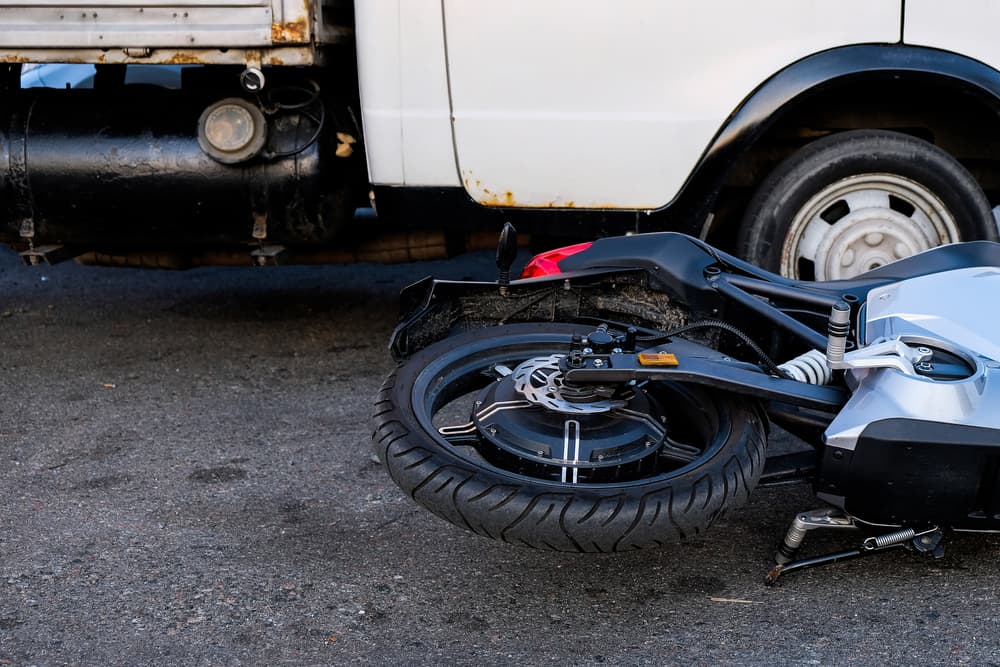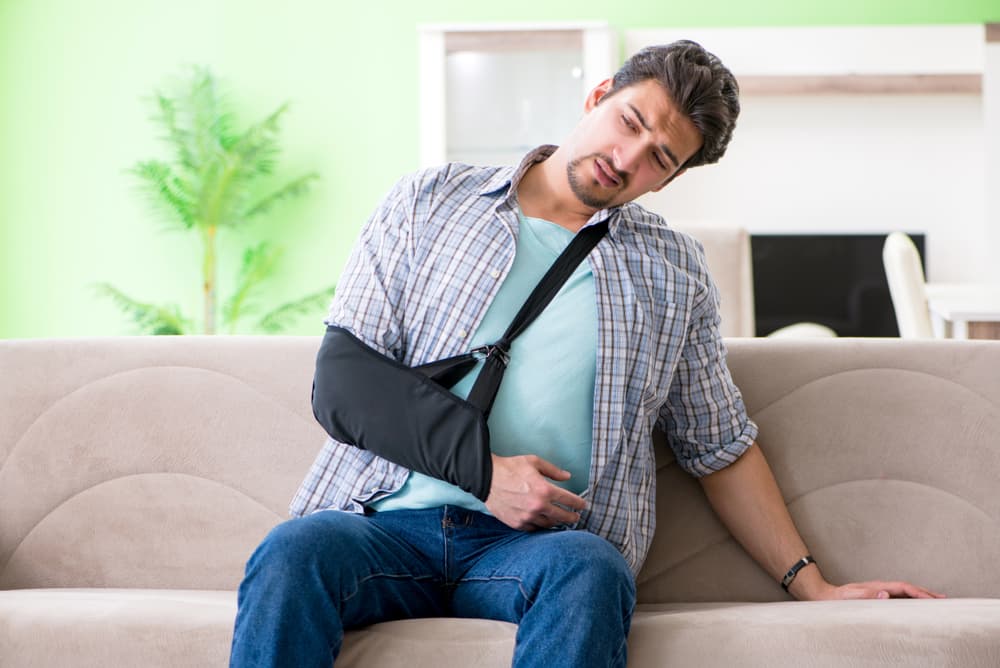Most motorcycle accidents result from other drivers’ carelessness and negligence, including distracted driving, intoxicated driving, reckless driving, road rage, and road- rule violations. At other times, however, motorcycle crashes may happen because of defective roadway conditions, such as grooved pavement, potholes, and deep cracks, all of which may dislodge a motorcyclist from their bike.
If you recently suffered injuries in a motorcycle accident that someone else caused, you may be eligible to recover compensation, depending on your individual circumstances. A skilled Edmonton motorcycle accident lawyer can estimate the likely settlement or litigation value of your personal injury case and take the necessary steps to secure the financial recovery you deserve.
Ways that Others Frequently Cause Local Motorcycle Crashes

Motorcycle accidents, unfortunately, can stem from various factors, often involving the actions or negligence of others. Other motorists, for example, may unintentionally contribute to these accidents by failing to check their blind spots, abruptly changing lanes, or underestimating a motorcycle’s speed. These lapses in attention can prove disastrous, leading to collisions that cause motorcyclists to suffer serious injuries.
Construction companies, when conducting roadwork, also play a role in the potential for motorcycle accidents. Incomplete signage, poorly marked detours, or neglected road maintenance can create hazardous conditions for motorcyclists. Potholes, loose gravel, or uneven surfaces often become treacherous obstacles, increasing the risk of accidents. It’s crucial for construction companies to prioritize safety measures to lessen these potential dangers.
Municipalities that are responsible for maintaining roads and traffic infrastructure may also contribute to motorcycle accidents. Inadequate traffic signal visibility, poorly designed intersections, or delayed repairs on roads can all compromise the safety of motorcyclists. Municipalities bear the responsibility of ensuring that roadway conditions are optimal to minimize the risk of accidents for all road users.
Moreover, the lack of awareness among other motorists regarding motorcycles can significantly contribute to accidents. Some drivers may overlook or underestimate the presence of motorcycles, failing to yield the right-of-way or misjudging distances. Education campaigns emphasizing motorcycle awareness can be important when it comes to reducing these oversights.
In general, motorcycle accidents often result from a combination of factors involving the actions or oversights of fellow motorists, construction companies, and municipalities. If you suffered injuries in a motorcycle crash stemming from someone else’s negligent behaviour, a skilled motorcycle accident lawyer in your area can review the police report, investigate your accident circumstances, and file a personal injury claim on your behalf.
How to Prove the Legal Elements of a Motorcycle Accident Claim or Lawsuit Successfully
When pursuing a motorcycle accident claim or lawsuit, establishing the necessary legal elements is crucial to building a strong case. First, it is important to document the accident scene thoroughly. Gathering evidence, such as photographs of the accident site, roadway conditions, and any relevant signage, serves as a tangible foundation for your claim. This visual record can vividly illustrate the circumstances surrounding your accident.
Eyewitness accounts also play an important role in corroborating your version of events. Obtaining statements from individuals who witnessed the accident provides firsthand perspectives that can validate your claim, increasing your case’s overall credibility.
Medical records are another vital component in proving the legal elements of a motorcycle accident claim. Seeking immediate medical attention after the incident not only ensures your well-being but also establishes a clear link between the accident and your injuries. Medical records detailing diagnoses, treatments, and prognoses become crucial evidence in demonstrating the extent of the harm you suffered in your motorcycle accident.
Communications following the accident, such as police reports and any exchanged information with the other party involved, also carry significant weight. Police reports provide an official account of the incident, documenting details like weather conditions and statements from those involved. Furthermore, exchanging information with the other party, including contact details and insurance information, creates an official record of the parties involved in the crash.
In addition to these tangible elements, it’s essential to maintain a comprehensive record of all accident-related expenses, including lost income. Doing so demonstrates the economic effect of the motorcycle accident on your life. This financial documentation also serves as tangible proof of the damages you’ve suffered, supporting your overall claim for compensation.
Ultimately, the strength of your motorcycle accident claim or lawsuit relies upon a combination of tangible evidence, credible witnesses, and thorough documentation. By carefully assembling this evidence, your personal injury lawyer can present a compelling case, increasing your likelihood of recovering the full compensation you deserve for your injuries.
Common Injuries in Motorcycle Collisions
Motorcycle accidents often result in a range of injuries, with some being more common than others. Among the most common injuries are fractures, frequently involving the accident victim’s extremities such as arms, legs, and wrists. These fractures may require immediate medical attention, often involving the application of casts or surgical intervention to ensure proper healing.

Traumatic brain injuries (TBIs) are another common consequence of motorcycle accidents, and they can range from concussions to more severe head injuries. Treatment for TBIs typically involves a thorough evaluation by medical professionals, and in severe cases, surgeries may be necessary to address bleeding or swelling in the brain. Rehabilitation, including physical and cognitive therapies, may also be crucial for a full recovery.
Road rash, resulting from friction between the motorcyclist’s skin and the road surface during a crash, is a common type of soft tissue injury. Treatment for road rash involves cleaning and dressing the wounds to prevent infection. In more severe cases, skin grafts may be necessary to promote healing.
Spinal cord injuries, though less common, can also have profound and lasting effects. Medical treatment for spinal cord injuries often involves stabilization of the spine through surgical procedures, followed by rehabilitation to regain function and adapt to any permanent changes.
Internal injuries, such as organ damage or internal bleeding, are also frequently seen in motorcycle accidents. Timely medical intervention is crucial to address these injuries, often requiring surgeries or other medical procedures to repair damaged organs and prevent further complications.
Injuries to the neck and back, including whiplash, are common as well. Medical treatment for these injuries may involve physical therapy, pain management, and, in some cases, surgical procedures to address the underlying issues.
While the specific injuries resulting from a motorcycle accident vary, the necessity for prompt and comprehensive medical treatment is a common thread. The road to recovery often involves surgical interventions, rehabilitation therapies, and ongoing medical care to address both the immediate and long-term effects of accident-related injuries. By prioritizing timely and appropriate medical treatment, individuals injured in motorcycle crashes can enhance their chances of a more robust recovery.
Litigating a Motorcycle Accident Case Successfully
When motorcycle collisions require legal action in the court system, a process known as litigation begins. The ultimate purpose of litigation is to determine responsibility for the motorcycle accident and seek financial recovery for all accident-related losses. The litigation process has several key phases, each of which serves a specific purpose.
- Initiating the process, the injured motorcyclist – or plaintiff – files a legal Complaint against the party deemed responsible for the accident (known as the defendant). This complaint outlines the details of the incident, the injuries sustained, and the damages sought. The defendant responds by presenting their version of events and defences in a legal document known as an Answer.
- Following this exchange, a phase of discovery begins. During discovery, both parties gather evidence to support their claims. This involves exchanging relevant documents, witness statements, and expert opinions. Depositions, where witnesses and parties involved are questioned under oath, provide a firsthand account of the incident. The goal of discovery is to uncover facts, assess the strengths and weaknesses of each side’s case, and bring about informed settlement negotiations.
- With the evidence compiled, the parties often engage in ongoing settlement discussions. This phase aims to resolve the case outside of court, potentially saving time and legal expenses. Negotiations involve assessing the merits of each side’s arguments and reaching a mutually agreeable settlement. If the parties can reach a settlement, the case ends without a trial.
- However, if the settlement negotiations fail, the case proceeds to trial. During the trial, both parties present their evidence, call witnesses, and make legal arguments before a judge and jury. The plaintiff, seeking compensation for damages, has the burden of proving the defendant’s negligence and the extent of harm which they suffered. The defendant, in turn, defends their actions and challenges the evidence which the plaintiff presents.
- Once both sides have presented their cases, the judge or jury deliberates and issues a verdict. If the verdict favours the plaintiff, a judgment is entered, specifying the amount of compensation awarded.
Motorcycle accident litigation involves filing a legal complaint with the court, followed by discovery, negotiation, and, if necessary, a trial. The outcome, whether through settlement or a court judgment, aims to address the damages that the injured motorcyclist suffered and assign responsibility for the accident.
Successfully Recovering the Compensation You Need for Your Losses Following a Motorcycle Crash
When an individual suffers an injury in a motorcycle accident, the pursuit of compensation involves consideration of various damages. These damages address the wide range of losses that the victim experienced post-accident, including both tangible and intangible consequences.
Economic damages represent the measurable financial losses resulting from a motorcycle accident. This category includes compensation for lost income – or lost earnings that resulted from an accident victim’s inability to work during their recovery time. Motorcycle accident victims may also be eligible to recover compensation for their loss of earning capacity. These damages are especially likely when motorcyclists suffer permanent injuries in their accident, such as full or partial paralysis, which limits their ability to work and earn income in the future.
Non-economic damages, on the other hand, focus on the intangible, often emotional, toll of the motorcycle accident. Mental anguish, reflecting the emotional distress and psychological effects of the incident, is one component of non-economic damages. This can encompass feelings of anxiety, depression, and overall emotional suffering that the accident victim experienced due to their physical injuries.
Inconvenience, while more challenging to quantify, is another aspect considered in non-economic damages. This involves the disruptions to the victim’s daily life and routine resulting from the accident, including challenges in performing regular activities and attending to personal responsibilities.
Past and future pain and suffering are also integral components of non-economic damages. Past pain and suffering refer to the physical and emotional distress endured from the time of the accident until the final case resolution. Future pain and suffering, on the other hand, account for the anticipated long-term effects and ongoing challenges the motorcycle accident victim may experience due to their injuries.
In essence, the types of damages available in a motorcycle accident case extend far beyond mere reimbursement for lost earnings. While economic damages cover tangible financial losses, non-economic damages address the emotional toll, inconvenience, and enduring pain and suffering. Together, these compensation elements strive to comprehensively address the various consequences of a motorcycle crash – and financially assist with the victim’s overall recovery.
Talk with an Experienced Motorcycle Accident Lawyer Near You Today

Motorcycle accident victims who suffer injuries have a limited amount of time in which to pursue legal action. In most circumstances, injured motorcyclists must bring a personal injury lawsuit within two years of their accident date. If they fail to file a timely lawsuit, the court will prevent them from recovering the damages they need for their accident-related losses.
If you recently sustained injuries in a motorcycle accident that occurred due to someone else’s negligence, an experienced Edmonton personal injury lawyer can help. Your lawyer can swiftly investigate the circumstances surrounding your accident, file a claim or lawsuit on your behalf, and pursue the monetary recovery you need for your losses – either through a favourable settlement offer from the insurance company or a favourable litigation result in the Alberta Court System.
Compensation will not happen automatically. You must take action to obtain the financial support you need following a motorcycle crash, so seek legal advice today.
